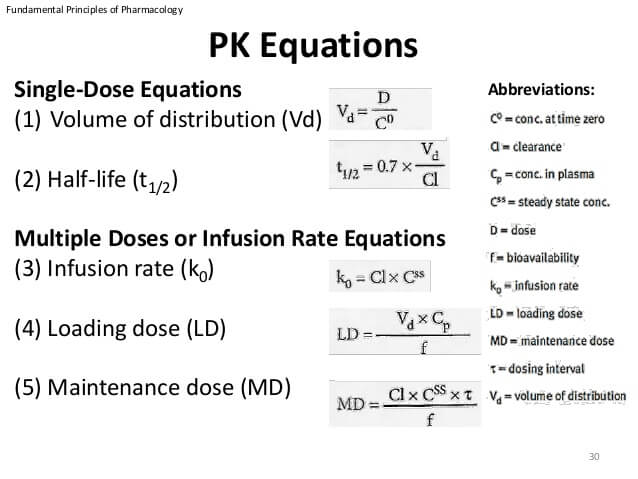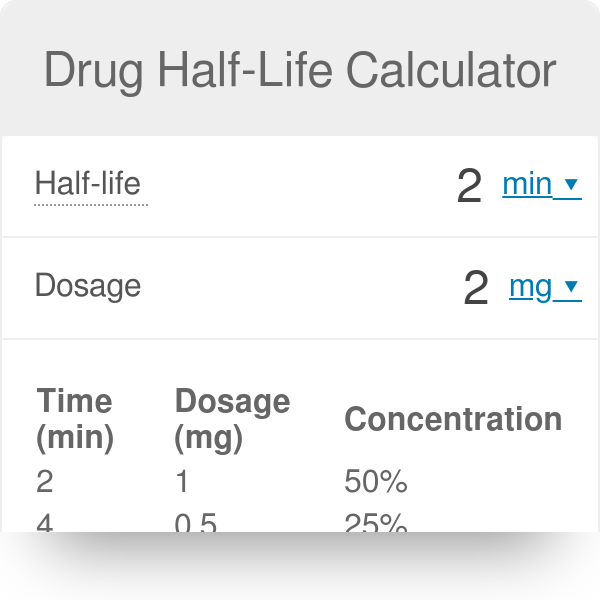half life formula pharmacology
Drug F has a half-life of 5 hours If 750mg is administered at 930 pm how much would be eliminated after 10 hours. Margin of Safety in Pharmacology.
K first order rate constant.
. The rule of thumb is that steady state will be achieved after 5 half-lives 97 of steady state achieved. Half-life Overview Half-life is the time it takes for a drug to reduce in amount by 50. In order to find the half-life we have to replace the concentration value for the initial concentration divided by 2.
T - the half life of a drug. If you have a drug with a long half life you can achieve a target steady state level. Half-life t½ is the time required to reduce the concentration of a drug by half.
λ is the slope of the plasma concentration-time line on a logarithmic y scale. Apparent half-life t 12. A 2 A 0 k t 1 2 displaystyle ce A2 ce A_ 0-kt_ 12 and isolate the time.
Inversely proportional to the fraction of the dose lost in each dosing interval. Half-life t 12 1. The formula for half-life is t½ 0693 Vd CL Volume of distribution Vd and clearance CL are required to calculate this variable.
Dosaget Dosage0 05 tT Where. Definition Formula Next Lesson. Effective half-life in clinical pharmacology.
Half-life is determined by clearance CL and volume of distribution V D and the relationship is described by the following equation. T 1 2 A 0 2 k displaystyle t_ 12 frac ce A_ 0 2k. Half-Life in Pharmacology - Quiz.
Effective half-life in clinical pharmacology J Clin Pharmacol. Dosing rate clearance rate x target concentration. In some cases such as for controlled-release preparations the rate of decline of the drug plasma.
Our drug elimination half life calculator uses the following equation. After 1 half-life you will have reached 50 of steady state. T - time that has passed since the first original administration of the drug.
Half-life t 12 is the time required to change the amount of drug in the body by one-half during elimination or during a constant infusionIn the simplest caseand the most useful in designing drug dosage regimensthe body may be considered as a single compartment as illustrated in Figure 32B of a size equal to the volume of distribution V. Half life Extraction ratio. Fractional rate of drug removal from the body.
This rate is constant in first-order kinetics and is independent of drug concentration in the body. Half-life allows the calculation of the time required for plasma concentrations to reach steady-state after starting or changing a dosing regimen. After 2 half-lives you will have reached 75 of steady state and after 3 half-lives you will have reached 875 of steady state.
Authors H Boxenbaum 1 M Battle. ER Dosing rate. Where t 1 2.
In pharmacology the concepts of half-lives and steady states are relevant to a patient. Effective half-life in clinical pharmacology. Half life formula half life equation Half life 0693k.
- The half-life allows us to predict the rate at which a drug will rise and fall in concentration based on the volume of distribution and clearance. Dosing rate Mghr x dosing interval in hours Loading dose Volume of distribution x target concentration area x permeability coefficient Thickness Protonated concentration. The formula for half life is t 1 2 l n 2 λ 0693 λ.
Affiliation 1 Wyeth. Half-life t½ is the time required to reduce the concentration of a drug by half. Half life formula pharmacology Thursday March 3 2022 Edit Biological half-life also known as elimination half-life pharmacologic half-life of a biological substance such as medication is the time it takes from its maximum concentration C max to half of its maximum concentration in the blood plasma and is denoted by the abbreviation.
Dosaget - the amount of drug present in. The formula for half-life is t½ 0693 Vd CL Volume of distribution Vd and clearance CL are required to calculate this variable. Drug P has a half-life of 4 hours.
By definition t 12 is the time required for the concentration to fall by one half. In this lesson we will define what a half-life is in pharmacological terms and explain how it is relevant. T 1 2 ln 2 V D C L displaystyle t_frac 12frac ln 2cdot V_DCL.
If 200mg is administered at 1100 am how much would be eliminated after 8 hours. Is the disintegration constant. Accumulation factor 1Fraction lost in one dosing interval 11 - fraction remaining For example the accumulation factor for a drug given once every half-life.
Quiz Worksheet - Half. Formula Half Life 0693 KE Half Life 0693 0015 462 hours So this means that the drug will take 462 hours to remove roughly half. Elimination rate constant λ.
For drugs with first order kinetics this is a constant. See the video below for more details.
Volume Of Distribution Pharmacology Flashcards Draw It To Know It

Elimination Half Life An Overview Sciencedirect Topics
Loading Dose Pharmacology Flashcards Draw It To Know It
Half Life Pharmacology Flashcards Draw It To Know It

Drug Half Life Explained Calculator Variables Examples

Pharmacokinetics Mnemonics Epomedicine

First Order Elimination Rate Constant And Half Life A Closer Look Lect 11 Youtube

Elimination Rate Constant An Overview Sciencedirect Topics
Maintenance Dose Pharmacology Flashcards Draw It To Know It



